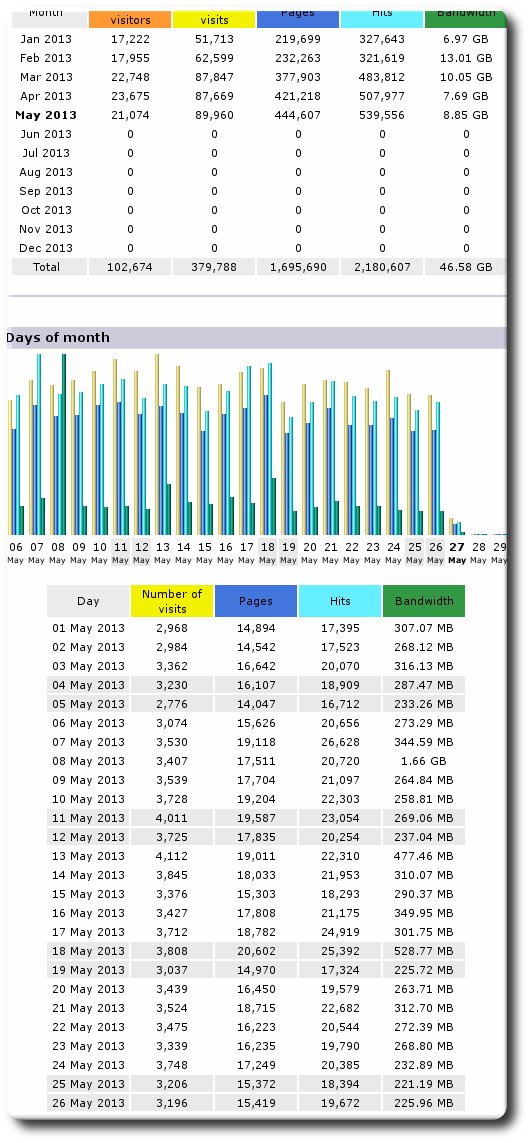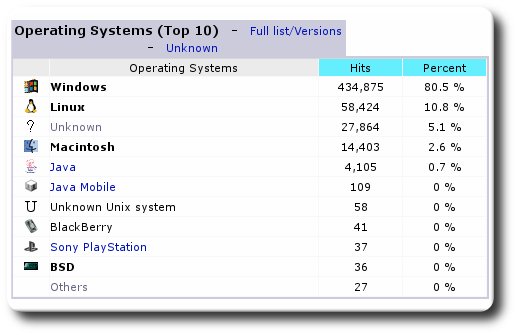Identi.ca becomes part of the ‘Internet rot’ problem

“Wait, What? Identi.ca Doesn’t Care About My Data???”
 ell, it just had to happen sooner or later. Face the facts. So-called ‘Cloud’ (or Fog as I prefer to call it) Computing is hype and it is dangerous not just in the security sense. Your data, or even your sentimentally-valued information, memories, etc. have no value to others, those who merely provide hosting for self gain or ego or whatever.
ell, it just had to happen sooner or later. Face the facts. So-called ‘Cloud’ (or Fog as I prefer to call it) Computing is hype and it is dangerous not just in the security sense. Your data, or even your sentimentally-valued information, memories, etc. have no value to others, those who merely provide hosting for self gain or ego or whatever.
Over the years I have seen many so-called ‘clouds’ collapse, whereas with my stuff, almost everything is in tact, even what was online a decade ago (maybe IP addresses changed a little, but it is all still “up there”). This is because to oneself, data matters and data has value. It’s my data. To Fog Computing providers, your data is just mere “content”, something for other users to “consume”, potentially for “monetisation” by the managing party.
Even if the ‘cloud’ is built on Free/Open Source software, and even if that software is made available for download, there is no guarantee that data will be exportable from the database. Identi.ca is a good example of this point (more on that later). What a travesty!
“Why Are You Surprised?”
I previously wrote about my experience losing all my data and work at Digg and Netscape (see the posts “Digg Stabs All Users in the Back, Deletes All Their Content, EVERYTHING!” and “With ‘Cloud Computing’ You Can’t Keep Your Data Under Your Control“).
One could rename and do a rendition of “never fall in love again” as “never fall in cloud again”. Fog Computing is toxic, and the more years go by, the more people (and businesses) will recognise this. From losing access to new binary releases or newly-updated source code people are now losing access to actual data, which they never even retained on their own devices in the first place. What a suicidal decision that would have to be…
“Backup? Export? Where’s the Profit in That?”
Some days ago I made an effort to advise Identi.ca to preserve content and make old URLs accessible, for the sake of preservation. About a week earlier I enquired about the backup feature (experimental) being broken and not allowing me to export my data; this had been broken for years! I never receives a response Right now it says it “provides an incomplete backup” and finally I can actually export some data, but only the past month’s data (I have posted there for over 4 years).
Recently, having suffers another major ‘cloud’ data loss, I made a local copy of all my tweets. Twitter’s archive dump is well-formatted after Twitter announced the feature (months ago) and refined it over time, making it available to all users and not just select few, taking minutes to generate an archive and then sending a notification by E-mail, indicating an archive is ready for download (I have posted nearly 85,000 tweets). This is a commendable move by Twitter, but still, given that Twitter traffic declined 20% in the past 3 months alone (based on Alexa.com), how long will Twitter be hosting the tweets itself and thus keep URLs in tact?
“Sites Go Dark? Never!”
Well, actually it happens all the time, usually financial considerations being a major factor for the operator/s. Consider all the third-party image hosting services and link shorteners such as http://ping.fm/ that I used a lot in 2009-2010. These latter services are a nightmare even in the eyes of the founder of the World Wide Web as lacking any contextual information like link/page, the URLs are worthless; they are utterly dead and useless links, they cannot be recovered even through the Web Archive. Often enough this renders the tweets too rather useless. If people use shorteners in blogs, then they are truly misguided and they too will suffer the consequences.
“Didn’t Identi.ca PR Say it Was Just a Conversion
Identi.ca is trying to call this a “conversion”, but the only thing such sites seem to be planning to convert is user accounts, and not even many of them. Reading “Identi.ca conversion to pump.io” again, it seems clear all user data will be deleted (not left online, thrown away). As manual backup is trimmed/incomplete, this leaves users like myself unable to even pull the raw data while the site and the database are still online. What incompetence; what a betrayal!
“So New Software Platform Means Starting From Scratch?”
It sure seems to be the case. “The Identi.ca social network service will be moving to a new software platform on June 1, 2013,” says the announcement. This is a nice way of saying that the site is reassessing the way it operates and perhaps the business/operating model, neglecting all that was put into it by many users. It started by stating the migration would occur in one of the secondary domains and now this is coming to Identi.ca, as some people feared.
In a month-old post titled “Identi.ca conversion to pump.io” says:
Active accounts will be converted automatically to the new platform. Active users don’t have to do anything to continue using the service.
Accounts that have not been used since May 1, 2012 will not be converted. If you have friends or people you like on Identi.ca that you think should keep being users, please let them know. Just posting one notice will mean their account gets converted.
If you’re interested in seeing how pump.io works right now, you can set up an account by going to http://pump.io/ and clicking the “try it” button.
pump.io has a very different API than StatusNet. If you use a desktop or mobile client for Identi.ca, please check with the software developer to see if they’re planning to port to pump.io.
Backups of all public data will be available on archive.org after the switchover. You can also make a manual backup.
pump.io is under active development; some features you’re used to from StatusNet will be unavailable or will be implemented by third parties. There are a lot of things that pump.io does better, though. Social games, sharing pictures, and web-wide social buttons are just part of the new fun.
How hard would it have been to just keep the old CMS in tact, even for the sake of old URLs being accessible? Probably trivial bar space and CPU concerns, right? Identi.ca should reconsider its position on this. Maybe Evan (Identi.ca founder) can ‘kickstart’ a fund-raiser to help sponsor this; I would put my money in to preserve my data. Maybe others would, too.
New Identi.ca means the following: Heaps of broken URLs, disregard for people’s work which was posted online (essentially just like in the case of Digg, Netscape/Propeller, etc.), and elimination of many connections like “Followers”/”Following”. It was bad enough when theme-related information got dumped as part of the previous software upgrade. Not the same is being done with post data. Only user data is preserved (name, E-mail, etc.). Imagine if YouTube did the same thing, throwing people’s videos out with the bathwater… YouTube did throw away people’s theme-related information when it applied some updated, but these are often restorable with some effort. The same goes for Facebook with its layout tweaks. Imagine the outrage resulting from a Facebook announcement that it is dumping all old posts and photos…
“So It’s All Gone in a Few Days?”
Seems so, unless Identi.ca decides to keep the StatusNet setup in tact, as least for legacy purposes (I have thousands of links to Identi.ca URLs out there, and they are needed for context).
I have some mirroring of selected Identi.ca accounts in a IRC channel, which I back up and make available online for good. Alas, that is hardly a substitute.
“What Can I Learn From This Disaster?”
When your online work (including Facebook, Twitter, etc.) will no longer align with someone else‘s business model, say goodbye to it all. Yes, seriously. This is not a charity.
Yesterday I wrote about self-hosting one’s photographs. No guarantee of export options in Flickr, eh? Are you listening, Flickr MicroHoo! users? As my friend Tract put it in “Tracy’s photo album,” this is “better than flickr! I won’t lose all of my pics when flickr disappears.”
Recently, speaking to relatives or mine, I advised them to access Friendster to export or save their accounts’ contents before it’s too late to do so. A stampede to export would cost a site in the process of shutting down a lot in terms of bandwidth, reducing incentive to provide such an option, especially when there is no brand/reputation to protect anymore. And if you think Twitter and Facebook are any different, think again. The only difference is, those sites are probably quite a few years away from shutting down and throwing the content down the drain. Why else would the Library of Congress already amass tweets of everyone? Spying concerns aside (profiling people based on their posts from decades in the past), this shows that the US government too recognises that all Fog Computing ends up the same way — it ends up down. Not up, down. Offline, probably stored on some magnetic tape/disc in some warehouse owned by some company which had nothing to do with the data and not making accessible online, even to those who provided all this data. In due course this storage media too will erode, collect dust, and become inaccessible (incapable or getting salvaged), in essence destroying the data for good and not even giving data contributors a chance to preserve/curate the data themselves.
“What Should Identi.ca Do?”
It’s simple. Keep the data up. Keep the old URLS in tact. Make the privately-owned database accessible one way or another. If the backup feature permits complete download of all data for a given user, then it doesn’t resolve all the issues, but it may resolve some.
 THER than the fact that Google Glass is Linux-powered and partly Free/Open Source, I have never had interest in Google Glass. The fact that it is hackable — in the sense one can install one’s own system on the hardware — sure makes a difference, but most people will never practise this freedom. As long as Google, by default, hoovers in data from Google Glass (like it does on the Nexus series), the data is easily accessible to the Surveillance Industrial Complex. This ties into the previous post about peer-surveillance. There is no escaping it and there is reason to antagonise Google Glass as a concept, irrespective of whether one buys/uses it. A lot of people will have no choice as to whether their life(as dynamic imagery) is taken and then uploaded to a datacentre with weak data sharing/protection/retention policy. This is not the same as CCTV. Here we talk about videos that are captured in private spaces, too, more so than surveillance drones whose motion is limited to aerial and is still privacy-infringing, albeit they’re less ubiquitous due to cost, air traffic control, legislation and so on.
THER than the fact that Google Glass is Linux-powered and partly Free/Open Source, I have never had interest in Google Glass. The fact that it is hackable — in the sense one can install one’s own system on the hardware — sure makes a difference, but most people will never practise this freedom. As long as Google, by default, hoovers in data from Google Glass (like it does on the Nexus series), the data is easily accessible to the Surveillance Industrial Complex. This ties into the previous post about peer-surveillance. There is no escaping it and there is reason to antagonise Google Glass as a concept, irrespective of whether one buys/uses it. A lot of people will have no choice as to whether their life(as dynamic imagery) is taken and then uploaded to a datacentre with weak data sharing/protection/retention policy. This is not the same as CCTV. Here we talk about videos that are captured in private spaces, too, more so than surveillance drones whose motion is limited to aerial and is still privacy-infringing, albeit they’re less ubiquitous due to cost, air traffic control, legislation and so on.





 Filed under:
Filed under: 

 raph theory is essential to the Surveillance Industrial Complex — the privatised branch which maps people and assigns risk levels to them, depending for example on who they meet/met and/or speak/spoke to. Facebook extracts an immeasurable amount of work previously carried out by the Surveillance Industrial Complex. It outsources the effort. The cost is being passed to the public in exchange for games and pseudo-status.
raph theory is essential to the Surveillance Industrial Complex — the privatised branch which maps people and assigns risk levels to them, depending for example on who they meet/met and/or speak/spoke to. Facebook extracts an immeasurable amount of work previously carried out by the Surveillance Industrial Complex. It outsources the effort. The cost is being passed to the public in exchange for games and pseudo-status.
 ell, it just had to happen sooner or later. Face the facts. So-called ‘Cloud’ (or Fog as I prefer to call it) Computing is hype and it is dangerous not just in the security sense. Your data, or even your sentimentally-valued information, memories, etc. have no value to others, those who merely provide hosting for self gain or ego or whatever.
ell, it just had to happen sooner or later. Face the facts. So-called ‘Cloud’ (or Fog as I prefer to call it) Computing is hype and it is dangerous not just in the security sense. Your data, or even your sentimentally-valued information, memories, etc. have no value to others, those who merely provide hosting for self gain or ego or whatever.




 Y 2013 BT saga continues. At this stage, it’s not a technical fault, now
Y 2013 BT saga continues. At this stage, it’s not a technical fault, now